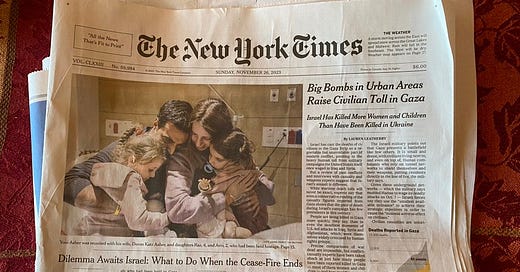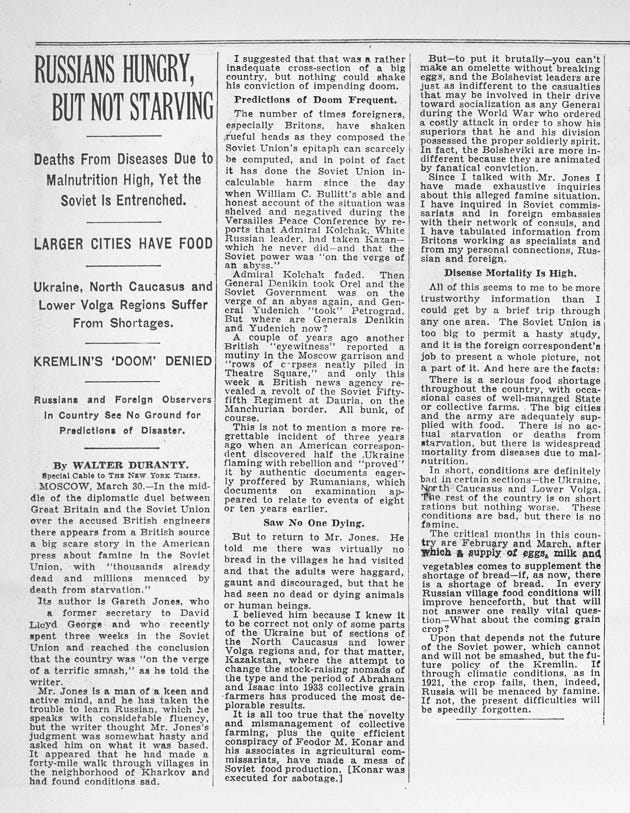Has Israel really killed more women and children than have been killed in Ukraine?
Or has something gone profoundly wrong at the The New York Times?
Note: I published these remarks in Global Eyes a few days ago, then mentioned this story again, yesterday, in a footnote. I’ve edited my comments into a single article and taken off the paywall: I think it’s in the public interest for these observations to be widely shared, particularly with the editors of The New York Times.
About two weeks ago, The New York Times published a disgraceful article on its front page, above the fold:
The online version bore a different headline, probably because someone realized that the original one was an embarrassment. This is the revised version:
“A historic pace?” We killed 30,000 civilians in Dresden in a single night. The headline is calculated to mislead. They’re speaking of deaths in the past quarter-century, not the past century as readers would initially think, particularly given the word “historic,” which is not, generally, a word used of the recent past. But even without this, the headline is completely misleading, because by “few” they mean “many.”
The damage is done: I have since seen the claim that Israeli is killing Gazans at a pace that puts Russia to shame everywhere, and particularly on social media, and particularly in response to any discussion of the aid package for Israel and Ukraine. The New York Times has succeeded in conveying to the world that no one has ever killed more civilians, faster, than Israel. The article is clearly meant to suggest that in Israel, we’re dealing with a uniquely criminal regime. It simultaneously managed to suggest that the Ukrainians are really just whining.
It’s hard to say which aspect of this article is most appalling. The stupidity? The mendacity? The incompetence? The vile animus toward Israel? The indifference to Ukraine? How is it that Lauren Leatherby and the editors of The New York Times have no idea of the magnitude and enormity of Russia’s war on civilians? The war in Ukraine is, after all, the most significant news story of the past decade—and it is a story that the Times has covered every single day since February 22.
Why would the Times publish a baffling piece of Kremlin propaganda precisely as aid for Kyiv hangs in the balance in the US Congress? What could they be trying to say, save that Russia’s invasion of Ukraine isn’t really all that bad, while Israel is uniquely monstrous? From this, the careless reader—which is most of them—would conclude that Gentle Mother Russia is carefully avoiding harm to women and children, as opposed to raping them, kidnapping them by the tens of thousands, and systematically targeting them in a relentless campaign of terror bombings.
This is Mariupol, where 75,000 civilians are estimated dead:
(The Times doesn’t even mention Russia’s war on Syrian and Chechen civilians—both of which took place in this century.)
I recently spoke, on our podcast, about the precipitous decline of academic and journalistic standards. If Claudine Gay is Exhibit A, this article is Exhibit B. I looked up Lauren Leatherby. She is, apparently, a “data journalist” with a masters degree in Public Policy from the Harvard Kennedy School. Given recent congressional testimony before Congress from the president of Harvard, perhaps I shouldn’t be surprised that one of its graduates has emerged from her education in a peculiar moral condition.
But this isn’t the main point. The main point is this: What is wrong with Harvard that they would give Lauren Leatherby a master’s degree in public policy without teaching her anything? How did she get a job as a “data journalist” without grasping that if you’re going to compare two sets of civilian casualties to another, you have to use something approximating same methodology to count them?
According to her LinkedIn profile, Lauren Leatherby studied “economics, statistics, computer science, finance, foreign policy, cybersecurity, human rights, and energy,” receiving a 4.0 GPA. Her list of honors is long: Phi Beta Kappa, Summa Cum Laude, Chancellor’s Scholar, the Governor’s Distinguished Scholar, Order of Omega Model Initiate (whatever that is), Fulbright Scholar, Dean’s List—the list goes on and on. She is the very pride and flower of our educational system. Yet no one ever taught her, in her entire academic career—or her career as a “data journalist”—how to use her noggin when handling data? To ask herself: “Am I actually comparing like to like?”
The list of obvious errors is incredibly long for a single article. First, she accepts Hamas’s casualty count at face value, even though her own newspaper was humiliated, just days before, when it excitedly published Hamas’s claim that Israel had bombed the Al Ahli hospital, killing 500. The Times was forced to scrub that headline hours later when it became clear that actually, Palestine Islamic Jihad had blown up a a parking lot. By that point, the Times had helped to touched off frenzied global protests and attacks on US troops. Hamas’s casualty count quickly dropped from 500 (a figure they somehow managed to produce within seconds) to “not very many and we don’t want to talk about it.” She has to know that, right? Usually, after an embarrassment like that, a newspaper learns to treat a source with skepticism. But no, Hamas’s claims are once again on the front page.
She writes: “International officials and experts familiar with the way figures are compiled by health officials in Gaza say the overall numbers are generally reliable.” Do they, now? Are they graduates of the Kennedy school too? If they say this, they’re idiots, too. This is Hamas we’re talking about—the paragons of probity who are still insisting that they killed no civilians on October 7. Their PR organs are flooding the Internet with photos of dead Syrian children, claiming they depict recent scenes in Gaza. Who takes Hamas’s word at face value about anything?
What about this graphic? Why didn’t this ring warning bells on the editorial desk?
The message couldn’t be clearer: Israel is bombing Gaza indiscriminately, so much so that women and children are dying in roughly the proportions they would if you just chose Gazans at random through a lottery and shot them. Buried deep in the article (in paragraph twelve), is the key point, however: “[O]fficials in the Hamas-run Gaza Strip do not separate the deaths of civilians and combatants.”
So what does this graph mean, then? Nothing. Note that it doesn’t count “male teenagers” separately. Half the population of Gaza is under the age of eighteen. It’s common sense to think no small number of Hamas combatants are male teenagers (unless we reckon the Izzedine al-Qassam Brigades are turning away eager applicants because they’re sticklers about Gaza’s child labor laws, scruples that were not in evidence when they put small children to work building their tunnels). We don’t know, from this visual aid, whether the number of fighting-age males it represents is 9, 90, or 9,000—and depending on the answer, our interpretation of it would be entirely different.
Other things we don’t know: How many of these deaths are owed to Hamas and PIJ misfires? Israeli radar trackers indicate that a full 10 percent of the rockets they try to launch land on Gaza itself. The IDF says that since October 7, 9,500 rockets have been fired at Israel, mostly from Gaza. If true, that means some 950 have landed in Gaza. We don’t know what proportion of the death toll is owed to this kind of own-goal, but when you fire a rocket at a dense urban area which, unlike Israel, has no air defense systems and no bomb shelters for civilian use, you can be certain the toll will be high. We also don’t know what percentage of this count represents the civilians Hamas murdered as they tried to evacuate to the south. This is all assuming we can take the 14,000 figure at face value, which we can’t.
Even if it were true that a greater proportion of women and children have died in this conflict than in other recent conflicts, the best explanation for this would not be that Israel is deliberately targeting women and children, as this story all but says directly. Gaza has an exceptionally young population. If you drop two equal-sized bombs, one in Gaza and one on a comparable part of Ukraine, a far larger proportion of the victims in Gaza will be children. Of course, far more will die in Gaza overall, because Ukraine not only permits but encourages its citizens to protect themselves underground, whereas Hamas refuses to share its bomb shelters with the people for whom it claims to be fighting.
But Ms. Leatherby is determined to ride or die with Hamas. She proceeds to compare Hamas’s estimate of Gazan civilian casualties with the UN High Commissioner of Human Rights’ tally of civilian casualties in Ukraine. She shouldn’t have been able to graduate from junior high school without knowing why this is ludicrous. You can’t compare a tally advanced by a combatant to one made by an independent body. And how could she not know that neither the UN nor any other independent organization has had access to the Russian-occupied territories for two years? Not only won’t Russia permit the UNHCR into cities like Mariupol, they’ve already bulldozed the buildings they’ve bombed and the civilian bodies they contained. We simply have no idea how many civilians have perished in cities such as Volnovakha and Severodonetsk. But we can be sure the toll is appalling, because we can see the mass graves from space:

The UN itself has said clearly that the real number of civilian deaths in Ukraine is “considerably higher” than its official total. The AP estimates 75,000 civilians were slaughtered in Mariupol alone—a figure seven times higher than the UN’s total for all of Ukraine.3 But she doesn’t need to take AP’s word for it: Here is her own newspaper, on August 22, 2022!
On Monday, the United Nations reported that it had confirmed the deaths of 5,587 civilians, including 149 girls, 175 boys and 38 children whose sex is unknown. At least 7,890 civilians were confirmed to be injured, it said. But those are only the confirmed civilian casualties. The true numbers, UN officials concede, are without doubt far higher. [My emphasis.] The actual toll is probably tens of thousands of civilians. That is the estimate Ukrainian officials have arrived at after months of recovering bodies.
The Mariupol casualty estimates have been significantly revised upward since then. The Times has reported that, too.
I shouldn’t have to explain this, but for this comparison to be meaningful, you must either compare figures that have been independently verified by the UNHCR—in which case the death toll in Gaza is “zero,” because they haven’t verified a single one of those deaths—or figures offered by combatants. A more relevant comparison would be to figures from the Ukrainian war crimes prosecutor—who, I note, has not recently embarrassed the Times by peddling ludicrous and mendacious casualty figures. The prosecutor estimates that more than 100,000 Ukrainian civilians have been killed. Other credible analysts think the number could be as high as 200,000.
How do you imagine Ukrainians feel when the United States’ most prestigious newspaper reports that really, invasion and occupation by Russia is quite humane? When they realize that no one on the entire editorial desk of The New York Times—neither reporters nor editors nor fact-checkers nor headline-writers—has the first clue about the horror Ukrainians have suffered, to the extent they’re unable even to put the number of Ukrainian civilians who have perished in the right order magnitude? When they see that the American newspaper of record is so indifferent to their slaughter, and so incurious, that they didn’t even look this up?
The flourish: They published this article on Holodomor Memorial Day.
Update: CAMERA—the Committee for Accuracy in Middle East Reporting and Analysis—was appalled by that story, too, and more meticulous than I was in their criticism: They went to the trouble of tracking down the sources of the quotes in the article. What do you know: Their comments were misquoted or taken out of context. They also noted even more outright falsehoods. Not “errors of interpretation”—falsehoods. The most vexing thing is this:
When presented with the details discussed below, the New York Times stood by its egregious misrepresentation of Iraq casualty statistics, which misleads readers into believing the civilian death rate in Gaza is six times higher than the rate in Iraq, despite them being, even according the the Gaza rate accepted by the paper, virtually identical.
That’s shocking. I truly did think that even if the Times had a distinct agenda, which obviously it does, it had professional editing and fact-checking protocols in place. Employees of the Times, I thought, would at least have enough of that enormous self-regard to care about not looking stupid in front of their peers. Shouldn’t it be too embarrassing to publish an article that makes it clear you don’t read your own paper and in fact pay no attention at all to the news?
I guess not.
Perhaps the original article can be chalked up to (stunning) incompetence. But they’ve refused to issue a correction. They know the article is riddled with errors. This represents complete collapse of professional standards. What’s more, the Times is now linking to that article in new reporting, every day, even though they know, for sure, that its claims are more than merely tendentious.
I still think there are some superb journalists at the Times. They have the money to do things other newspapers can’t, and often, their reporting is outstanding—although until now, I assumed it wasn’t fictitious, so maybe I have to revise my views about that.









Very good article. I just sent it to the son of a friend who was an Israeli paratrooper and has (of course) been recalled to active duty. Hopefully it will provide a little morale boost.
It also helps me, because when my bleeding heart liberal friends cry that Israel has killed more women and children than have been killed in Ukraine, instead of just saying, "So what? Of what possible relevance is that?", I can now hit back with some facts. So thanks for that.
Keep up the good work.
Thanks for informing readers about the NY Times death count errors